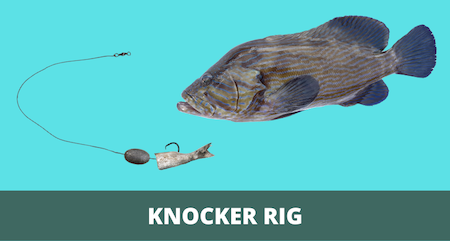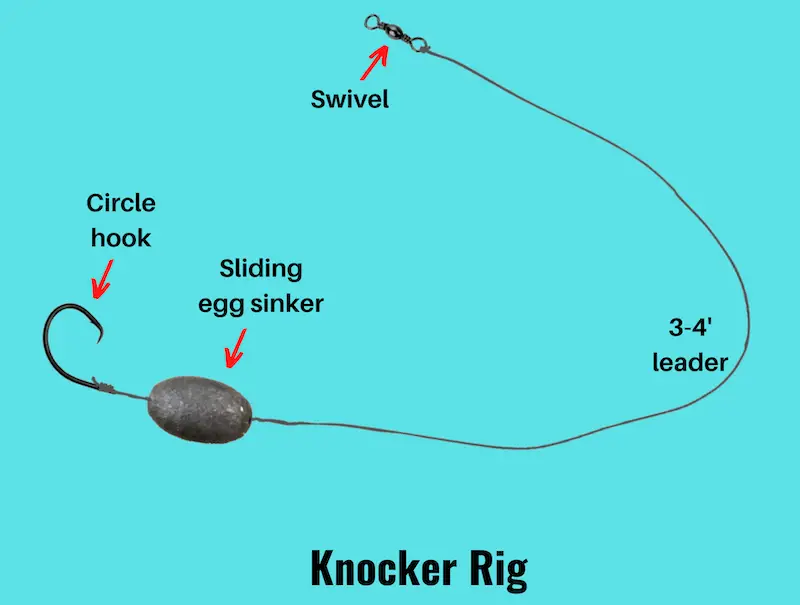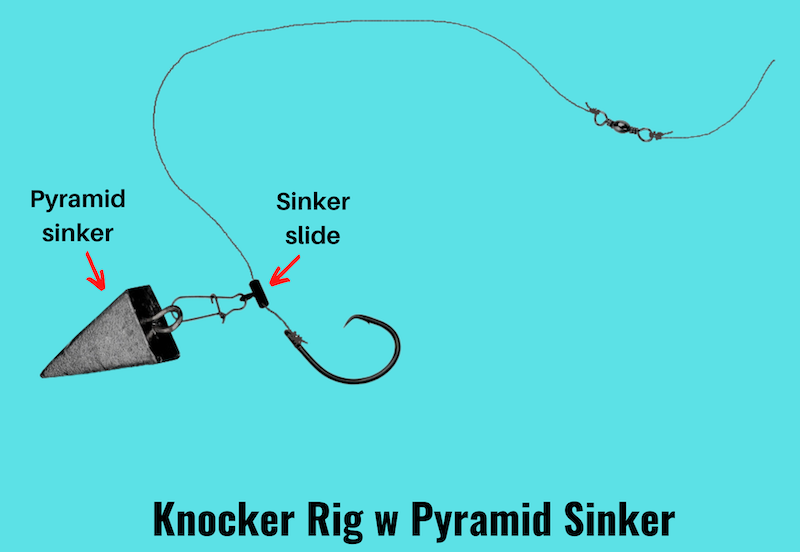Knocker Rig 101 (Setup & Fishing Guide with Pictures)
PUBLISHED 16 AUGUST 2023
by Robert Ceran
Are you planning to throw a knocker rig, but aren’t sure how to set it up, or how to fish it for optimal results?
While the knocker rig is one of the best bottom fishing rigs for saltwater, it can be a little tricky to set up and fish correctly.
In this article I’ll explain how to set up a knocker rig for bottom fishing, and will aso cover what bait to use with it, and how to fish it effectively..

What is a knocker rig (and what is it good for)?
A knocker rig is a bottom fishing rig used for both offshore and inshore fishing that consists of a circle hook tied to the end of the fishing line, as well as a sliding egg sinker that rides on the line above the hook.
While this setup is broadly similar to the Carolina rig and the slip sinker fishing rig, the main difference is that the sliding weight of the knocker rig is rigged onto the leader, while it is rigged above the leader (and onto the main line) on the other two rigs.
The advantage of the knocker rig is that it is much more compact while casting, and this results in fewer line tangles than with most other types of bottom fishing rigs. The tangle-free property of this setup makes it ideal for surf fishing, where you often need to cast your rig over long distances in order to reach the fish.
In addition to surf fishing, a knocker rig can also be used for fishing from a boat or pier, and is great for catching goliath grouper, snapper, amberjack, tarpon, red drum, rockfish, flounder and many more in saltwater, as well as catfish in freshwater.
Another advantage of the knocker rig is that it is very easy to set up, which makes it a highly beginner-friendly bottom fishing rig.
Knocker rig components
Below are the tackle components that you’ll need for your knocker rig setup:
- Size 5/0 to 2/0 circle hook
- #2 Barrel swivel
- 1 to 3 oz sliding egg sinker
- 3 to 4 for feet of monofilament or fluorocarbon leader (20 to 30 lb test)
- Plastic bead (optional)
I like to use 30 to 50 lb test braided fishing line as my main line, but you can also spool your reel with monofilament. In the latter case, you may not even need to tie a leader.

But keep in mind that it’s usually better if you use a main line that is slightly stronger than the leader line. That way if you get snagged and need to break the line off, you’ll only lose your terminal tackle.
And by the way, one of the advantages of the knocker rig is that it is often possible to get your hook unstuck if it gets snagged on a rock.
Just release some line to get the sinker to slide up the leader a little, and then quickly lift up your rod tip. This causes the sinker to drop down onto the hook, which is often enough to knock it free from the rock.
How to tie a knocker rig
Start by tying your leader line to the eye of the hook with a snell knot or palomar knot. Next, thread the leader line through the sliding sinker, and tie the tag end of the leader to the barrel swivel.
If you like, you can also thread a plastic bead between the sinker and the hook, as well as between the sinker and the swivel. This is not essential, but if the sinker has a hole with a large diameter, it may get stuck on your knot, which could damage the line.
In general, it’s better to get high quality sliding sinkers that don’t damage your knots, which allows you to avoid the plastic beads. Some anglers claim that the beads can spook finicky fish, although I haven’t noticed this myself.
If you’re using the knocker rig for fishing in heavy currents, another option is to use a pyramid sinker instead of an egg sinker (see image below), since this type of sinker bores down into the sand, and is better at holding the rig in place in strong currents.

This variant of the knocker rig is also called a cannonball rig, and is often used for catching redfish in surf with strong tides.
What bait should you use with a knocker rig?
Many anglers like to use the knocker rig with live bait, such as small live mullets, pinfish, or mackerel.
Live bait is great for targeting groupers and large snappers with a knocker rig, as you can lower your setup to the bottom, and then let the live baitfish dance enticingly in the water until a hungry grouper puts an end to it.
But cut bait works just as well on the knocker rig, and your options for this are virtually endless. Personally, I prefer to use oily fish, such as mackerel, sardines, or tuna, but you can also use squid strips, shellfish, or shrimp.
As always, try to secure freshly caught fish for cut bait, as frozen fish is nowhere near as effective in terms of the scents and oils that it releases into the water.
If you catch a tuna or bonito, you can always cut some chunks out of their meat to bait your rig, as the bait doesn’t get any fresher than that.
How to use a knocker rig
The best strategy is to use the knocker rig near cover, such as reefs, wrecks, piers and rock piles, which are often used by bottom-dwelling fish to ambush their prey.
You can drop your knocker rig vertically from a boat anchored next to one of these structures, or you can cast out your rig from shore. The weight will keep the bait close to the cover, which is where you can expect to get bites.

Image source: instagram/@cabosurfcaster
After your sinker reaches the bottom, it’s best to open the bail of your reel, to let the current (or a live baitfish, if that’s what you’re using) pull the line through the sinker, so it can slide back up the line. That will give your baited hook some space, allowing it to move around a little in the current.
It’s important to reel in your rig every 20 minutes or so, to make sure the bait is still on the hook. Also, when you retrieve your rig, pause it regularly to give fish a chance to eat the bait.
Knocker rig vs fish finder rig (which one is better?)
The main difference between the fish finder rig and the knocker rig is that the former has a sliding weight that rides on the main line, while the latter has a sliding weight that rides on the leader.
As a result of this difference, the fish finder surf rig is harder to cast over long distances without the leader getting tangled with the main line, as it tends to “helicopter” during the cast.
The knocker rig, on the other hand, is more compact (with the weight sitting right on top of the hook during the cast), and this setup almost never gets tangled when you cast it out.
However, the knocker rig comes with one key disadvantage: the amount of line that you can play out through the sinker is limited to the length of the leader.
The fish finder rig, on the other hand, allows you to play out as much line as you want, which can be helpful if you want your bait to be carried with the current in search of fish.
In summary, each rig comes with its own pros and cons, and which one you choose depends on where and how you want to fish it.
The knocker rig is the better option if you need to cast far out into the surf, while the fish finder rig is better if you don’t need to cast that far, and if you want your baited hook to be carried along with the current.
